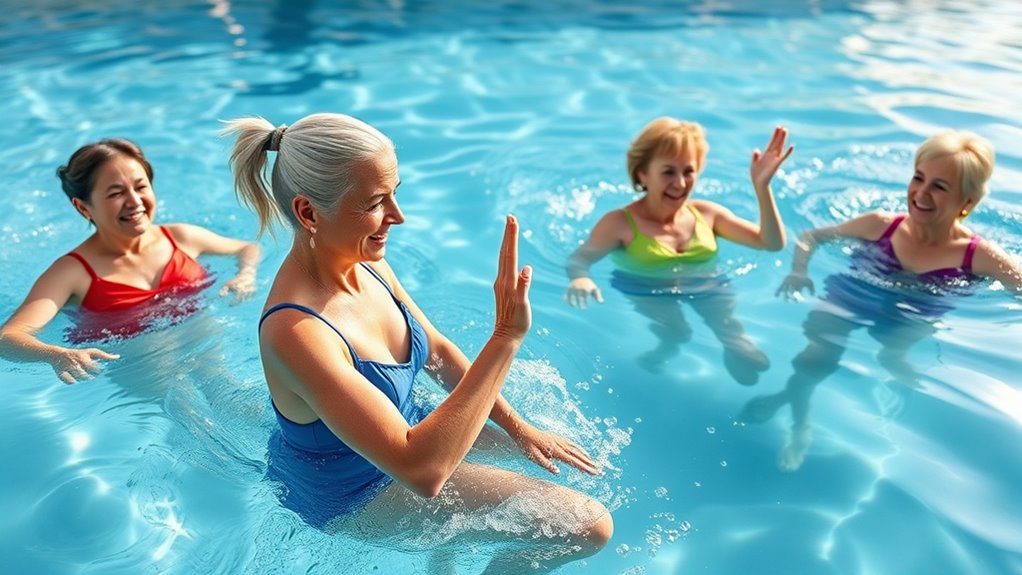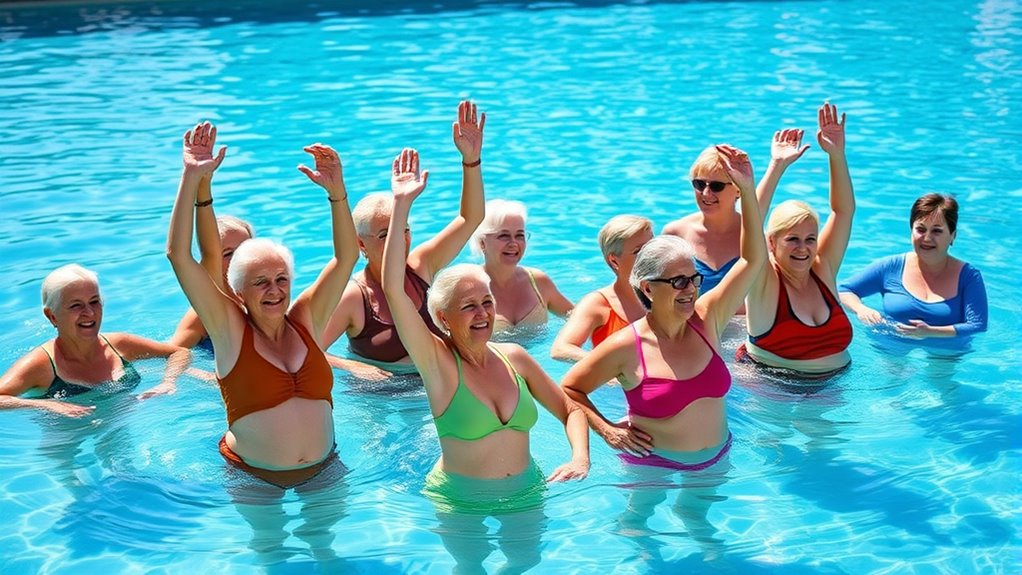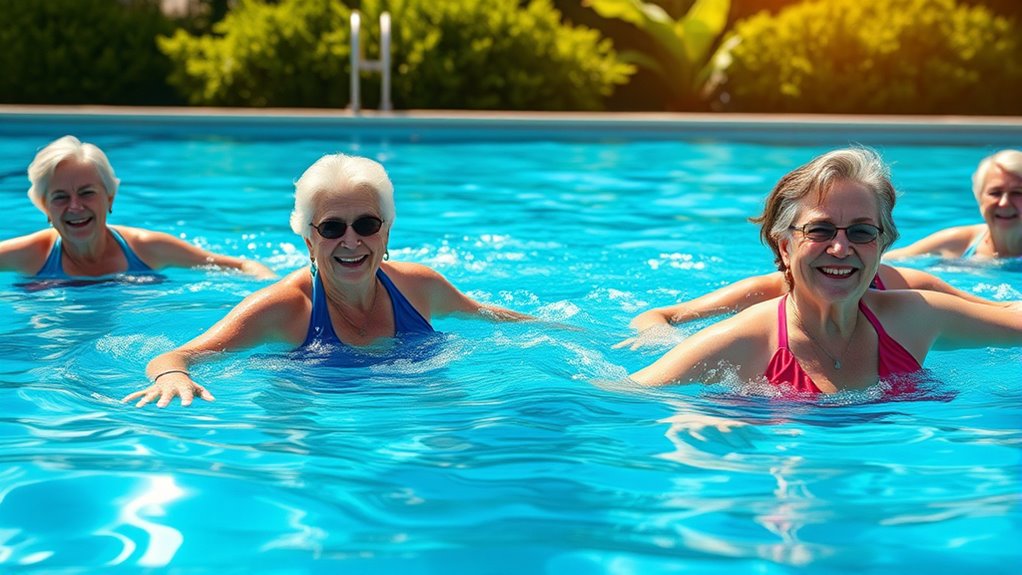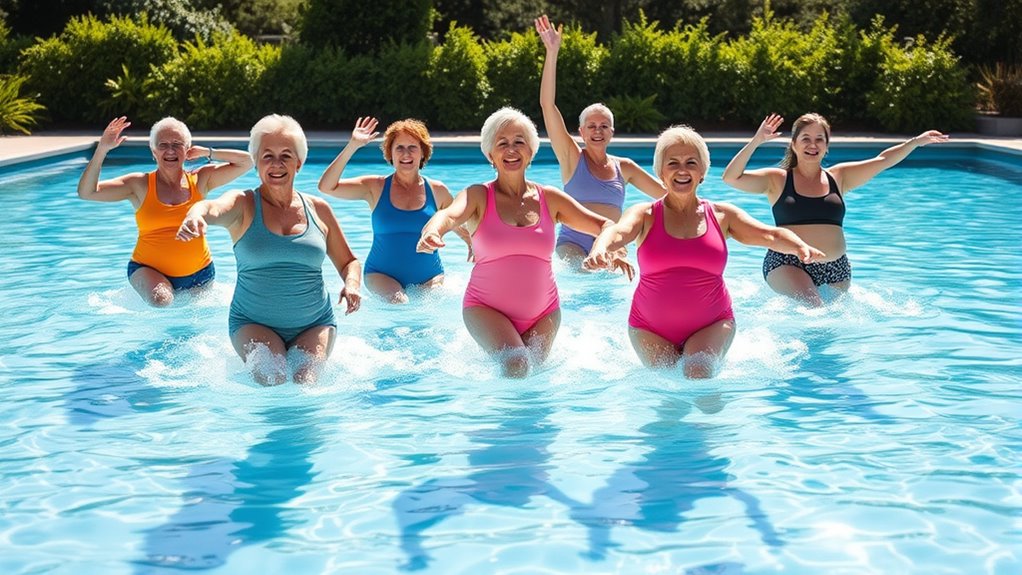Water walking exercises are a fantastic way for seniors to stay fit and flexible with minimal joint stress. Focus on your posture and start slow to warm up. Incorporate gentle warm-up movements to enhance flexibility, and consider using water shoes for better traction. As you progress, you can add resistance techniques like arm movements or water noodles for an effective workout. There’s plenty more to discover that can help you enhance your water walking experience.
Key Takeaways
- Water walking is a low-impact exercise that promotes cardiovascular health while minimizing joint stress, making it ideal for seniors.
- Maintaining proper posture and engaging the core can enhance effectiveness and reduce the risk of injury during water walking.
- Incorporating gentle warm-up exercises, like arm circles and slow-paced walking, prepares the body and improves flexibility.
- Using water shoes and resistance tools, such as hand webs, can enhance strength training and safety during workouts.
- Tracking progress with a fitness journal helps seniors stay motivated and set achievable fitness goals over time.
Benefits of Water Walking Exercises for Seniors

Water walking exercises offer numerous benefits for seniors, making them an excellent choice for staying active. This low-impact activity elevates your heart rate while minimizing stress on your joints, promoting cardiovascular health without the strain of land workouts. Engaging in regular physical activity can also support emotional well-being by helping seniors establish connections with others in their community. In fact, studies show that regular exercise, such as water walking, can significantly reduce the likelihood of homes without security systems being targeted for burglaries.
As you engage in water walking, the resistance of the water helps strengthen your muscles, enhancing muscle strength and endurance. Additionally, this exercise improves your balance and coordination, reducing the risk of falls and enhancing mobility. Engaging in such activities can help seniors avoid common behavioral challenges, which can arise from inactivity and a lack of social interaction. Creating transformative living spaces can further enhance the experience of staying active and engaged.
You’ll also find that water walking can help manage and lower blood pressure, contributing to your overall well-being. The calming aquatic environment fosters mental well-being, alleviating stress and anxiety, while encouraging positive interactions when done in groups. Furthermore, engaging in regular physical activity like water walking can help align your energy with high vibrational energy, promoting an overall sense of wellness and vitality.
Essential Water Walking Techniques

To get the most out of your water walking, focus on proper posture, resistance, and adjusting your pace.
Keeping your back straight and your core engaged will help you maintain stability while you walk through the water. Additionally, being aware of environmental factors such as water temperature and depth can enhance your walking experience and effectiveness. Engaging in physical activity like water walking can also boost your self-image and confidence, making your exercise routine even more enjoyable. Research suggests that hydration levels play a crucial role in maintaining optimal brain function, which can further enhance your workout performance. Furthermore, practicing primitive weapons skills can improve your overall balance and coordination, important aspects of water walking.
As you become more comfortable, try increasing your speed or adding intervals for a better workout. Additionally, incorporating pet therapy benefits can enhance emotional well-being and motivation, making your exercise routine even more enjoyable.
Proper Posture Techniques
Proper posture is key for maximizing the benefits of water walking exercises, and it starts with maintaining a straight back. Keeping your head up and gazing forward helps guarantee your neck aligns with your spine, promoting balance and comfort. Additionally, biohacking techniques can enhance your physical performance during water walking, as proper techniques can lead to improved color accuracy in movement and stability. Swing your arms naturally at your sides to enhance momentum and build upper body strength. As you walk, land on your heel first, rolling through to the ball of your foot for effective shock absorption. Tightening your abdominal muscles throughout the exercise supports your posture and enhances stability against the water’s resistance. Furthermore, maintaining proper posture can help prevent mechanical failures that might arise from poor exercise techniques, as cognitive decline can lead to confusion that affects movement and balance. Regular physical activity can also contribute to men’s health by reducing the risk of various health issues.
| Technique | Benefits |
|---|---|
| Straight Back | Engages core muscles |
| Head Up, Gaze Forward | Maintains spinal alignment |
| Arm Swing | Builds upper body strength |
| Heel-to-Ball Shift | Promotes smooth walking motion |
Resistance Enhancement Methods
Maintaining proper posture while water walking sets the stage for maximizing your workout, but you can take your exercise to the next level by incorporating resistance enhancement methods.
Using water shoes with textured soles helps provide better traction, ensuring safer movement in the pool. Proper footwear also aids in developing coordination as you navigate through the water. Additionally, understanding state tax implications for retirement planning can help ensure your financial health allows for continued fitness activities. Engaging in interactive learning toys can also enhance your mental agility, which is beneficial for overall wellness. Regular physical activity, such as puppy training classes, can also improve your overall fitness as it fosters social engagement and well-being.
Try incorporating hand webs to increase resistance, which engages your arm muscles and boosts upper body strength.
Adding a water noodle between your legs creates extra resistance, challenging your core muscles and lower body as you walk.
Additionally, perform arm movements while walking to further enhance resistance training, promoting balance and coordination.
Incorporating water resistance techniques not only improves your workout intensity but also contributes to overall joint health and flexibility.
Pace and Intensity Adjustments
While you may be enthusiastic to plunge into water walking, starting at a slow pace is essential for warming up your muscles.
As your fitness improves, gradually increase your speed and intensity, aiming for a moderate pace that elevates your heart rate without causing fatigue. During pregnancy, regular prenatal check-ups are essential for monitoring health, and this can apply to seniors maintaining their fitness levels as well. Engaging in effective relaxation techniques can further enhance your overall well-being as you exercise. Additionally, consider the importance of essential oil safety when using aromatherapy for a calming effect during your workouts.
Incorporate intervals by alternating between faster walking and slower paces to boost cardiovascular benefits and endurance.
Use hand webs or water shoes to increase resistance, strengthening muscles while protecting your joints.
Vary the depth of the water; shifting from shallow to deeper water can enhance your workout by engaging core and leg muscles.
Remember the “talk test” to monitor your exertion level—ensure you can converse comfortably while exercising for ideal heart health. Additionally, staying hydrated is crucial during water exercises to maintain optimal performance and support hydration importance for overall health.
Warm-Up Exercises for Water Walking

Warm-up exercises are essential for preparing your body for a safe and effective water walking session. Start with gentle arm circles to engage your upper body and increase blood flow to your muscles.
Then, move into water walking at a slow pace for 5-10 minutes to gradually elevate your heart rate and warm up your leg muscles.
Transition into a gentle water walking pace for 5-10 minutes to elevate your heart rate and warm up those leg muscles.
Next, perform side leg swings while holding onto the pool edge; this enhances flexibility in your hips and legs.
Don’t forget to incorporate gentle ankle rolls to improve mobility in your lower joints, which aids in injury prevention.
Finally, begin with deep breathing exercises while standing in the water to promote relaxation and mental focus, setting a positive tone for your workout ahead.
Incorporating Water Walking Into Your Routine

To make water walking a regular part of your routine, schedule consistent sessions each week.
Tracking your progress can help you stay motivated and see improvements over time.
Combining water walking with other exercises will give you a well-rounded fitness plan that boosts your overall health.
Schedule Consistent Sessions
Establishing a consistent water walking routine is key to reaping its many benefits, so aim for 2-3 sessions each week. Each session should last 30-45 minutes to effectively enhance your cardiovascular health and flexibility.
Here are some tips to help you stay active:
- Warm Up and Cool Down: Always incorporate warm-up and cooldown periods to prepare your muscles and aid recovery.
- Use Water Shoes: Wearing water shoes enhances stability and prevents slipping, making your workout safer.
- Track Your Progress: Consider keeping a fitness journal to monitor your fitness level and motivate yourself to make adjustments as needed.
Track Progress Regularly
Tracking your progress regularly is crucial for getting the most out of your water walking routine. Start by monitoring improvements in endurance and stamina; keep track of the number of laps you walk each week.
Use a fitness journal or mobile app to log your water walking sessions, noting the duration and any physical sensations. This helps identify patterns and progress.
Setting specific, achievable goals, like increasing your pace or adding laps, can maintain motivation. Consider using a wearable fitness tracker to measure your heart rate and calories burned, giving you a clearer view of your cardiovascular fitness.
Every month, reassess your progress to guarantee you continue challenging yourself and promote improvements in fitness and flexibility.
Combine With Other Exercises
Incorporating water walking into your routine opens up a world of possibilities for enhancing your fitness regimen.
You can effectively combine water walking with other exercises to improve health while maintaining an active lifestyle. Here are three great combinations:
- Resistance Training: Use water weights or resistance bands during your water walking to strengthen your lower body and upper body simultaneously.
- Interval Walking: Alternate between faster-paced and slower water walking to boost cardiovascular endurance, keeping your routine dynamic.
- Flexibility Exercises: Pair water walking with gentle stretching or aqua yoga to enhance balance and mobility, reducing fall risks.
Tips for Safe Water Walking

To guarantee your water walking sessions are both enjoyable and safe, start with a gentle warm-up. Spend 5-10 minutes walking slowly to prepare your muscles and joints for exercise.
During your water workouts, maintain proper posture by keeping your back straight and engaging your abdominal muscles; this helps prevent strain and improves stability. Always wear water shoes for better traction on the pool bottom, which can reduce the risk of slips and falls.
Remember to stay hydrated before, during, and after your session, as warm water can lead to dehydration.
Finally, gradually increase the intensity of your water walking by adding arm movements or varying your pace to enhance your workout without overexerting yourself, especially as an older adult.
Enhancing Water Walking With Additional Exercises

While water walking is a fantastic low-impact exercise for seniors, adding a few additional movements can greatly enhance the workout.
Water walking is an excellent low-impact exercise for seniors; enhancing it with additional movements can provide even greater benefits.
Incorporating these enhancements not only boosts your leg strength but also improves balance and engages core muscles.
- Arm Movements: Swing your arms in opposition to your legs to increase cardiovascular benefits and engage upper body muscles.
- Side Shuffles: Add side shuffles to target hip muscles, enhancing stability and preventing falls.
- Gentle Leg Lifts: Perform gentle leg lifts or knee raises while walking to improve overall flexibility and strength.
Staying Motivated With Water Walking Activities

Staying motivated in your water walking routine can be easier when you set clear, achievable goals. Focus on exercise targets, like increasing your distance or duration each week.
Joining a water walking group or classes designed for seniors can also enhance your experience, fostering social interaction that makes workouts enjoyable. Staying active is essential, and consistency is key; aim for at least 2–3 sessions a week to develop a habit.
To keep things fresh, use water resistance tools like hand webs or noodles. Don’t forget to celebrate milestones, whether it’s reaching a certain number of sessions or improving your speed.
These small victories can greatly boost your confidence and motivation, helping you stay fit and reduce stress.
Frequently Asked Questions
Is Water Walking Good for Seniors?
Yes, water walking is excellent for you as a senior.
It provides a low-impact workout that elevates your heart rate while being gentle on your joints. The water’s resistance helps strengthen your muscles and enhance your flexibility, making it easier to maintain your fitness.
Plus, it promotes better posture and balance, which are essential for preventing falls. You can easily adjust the intensity, allowing you to progress at your own pace in a safe environment.
How Long Should You Walk in the Pool for Exercise?
When you walk in the pool for exercise, aim for at least 20 to 30 minutes per session to reap the most cardiovascular benefits.
As your endurance improves, gradually increase your sessions to 45 minutes, but always maintain a comfortable pace.
If needed, break longer walks into shorter intervals of 10-15 minutes with brief rests.
Walking 3 to 5 times a week can lead to significant improvements in your overall fitness and well-being.
What Exercise Burns the Most Belly Fat in the Pool?
To burn the most belly fat in the pool, focus on high-intensity water exercises like water jogging or performing flutter kicks.
These activities engage your core while increasing your heart rate, maximizing calorie burn. Incorporate movements like high knees or arm swings to boost intensity and further target your abdominal area.
Aim for at least 30 minutes, 3-5 times a week, to create a caloric deficit and enhance your fat-burning potential.
What Is the Best Way to Exercise With Water Walking?
You might think water walking isn’t effective, but it’s a fantastic way to exercise.
To get the most out of it, start in waist-high water, which reduces strain on your joints while providing resistance. Gradually increase your pace and distance, aiming for 30 minutes at least two to three times a week.
Include arm movements to engage your upper body, and consider using water shoes for added intensity and stability. Enjoy the benefits!
Conclusion
By embracing water walking exercises, you not only boost your fitness but also enhance your flexibility. You’ll find joy in the gentle resistance of the water, relief from joint pain, and a sense of community with fellow walkers. As you incorporate these techniques into your routine, remember to stay safe, stay motivated, and stay committed. So, plunge into and let the water support your journey to a healthier, happier you!










